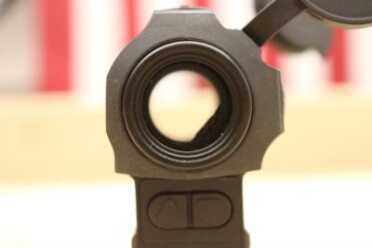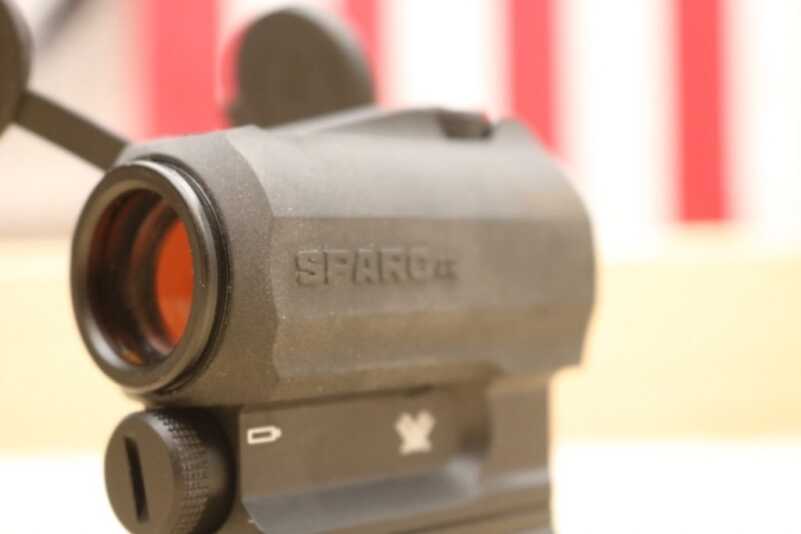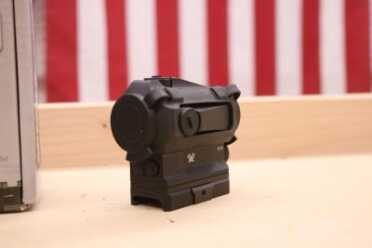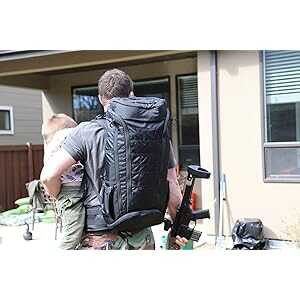One of the biggest problems in the past with red dot electronic sights is that they existed in exactly two categories. There was the super premium, salt water submergible, dust/ EMP proof, hostage rescue unit rated that cost roughly $800. It was a fantastic sight, but the price point for 1X magnification is about the same as buying a spare rifle. The other category was the sub $100 red dots, which may or may not hold zero long enough to drive home from the range. Known for their optics and high-quality products, Vortex has stepped in to fill the natural gap in this market with the Sparc AR red dot.

The author found the Vortex Sparc AR to be reliable, durable and high-quality during testing. It has yet to lose its zero and remained reliable over the course of the last month.
SPECS

The Vortex Sparc AR has a 2-MOA red dot that illuminates when activated. It makes for easy target acquisition.
- Magnification: 1X
- Objective Lens: 22mm
- Eye Relief: Unlimited
- Adjustment Graduation: 1 MOA
- Max Elevation Adj.: 90 MOA
- Max Windage Adj.: 90 MOA
- Length: 2.9 in.
- Weight: 7.5 oz.
- MSRP: $259
- Manufacturer: Vortex
Is there a reason, in this day and age, that a red dot sight should cost close to $1,000? Considering that price point has been the same for close to a decade, I highly doubt it. Can you buy anything of quality for $100? Probably not. The iron sights on my pistol cost more than that. Somewhere in between, Vortex has capitalized at delivering a quality product for a fraction of the price of others on the market. The Vortex Sparc retails at an MSRP of $259, though street price is closer to $200.
Comparing the Sparc AR to the market leader in red dots is a bold move, considering you could buy four of the Vortex for the price of one of the more expensive red dots. Still, a gold standard is a gold standard. It sets the value proposition of everything else.
The Sparc is a bit bigger in every dimension, but not by much. Although this size difference is completely irrelevant if you are looking at this as a primary optic for your rifle. The elevation and windage turrets are protected by a sloping chunk of metal integrated into the housing of the unit, which should prevent you from sheering them off in all but the most unlikely of blows. You would have to swing your rifle in such a way as to hit a ½ inch wide obstacle perfectly to directly hit to the turret. The turrets feature a knurled removable cap to further protect them, with a slot cut into the top of the cap to make adjustments with. The Sparc is covered with a protective rubber outer shell, designed to absorb most to the abuse you throw at it. One feature I really liked was the lens covers are integrated into this rubber shell. When using the optic, they snap together and stay out of your way. This makes them nearly impossible to lose. What a great design feature.
Vortex designed this optic to run on a simple household AAA battery. This is a nice departure, now that Uncle Sugar doesn’t buy me CR-123 or CR-2032 batteries. This yields you 300 hours of use at maximum brightness or 5,000 hours at minimum brightness. The only downside, depending on your point of view is that this requires a fairly large battery housing, located beneath the optic. That takes us right into mounting options.
As a stand alone optic, the Sparc AR shines. Included in the box are an absolute co-witness and lower one-third co-witness option. Co-witness meaning it lines up roughly with your iron sights as height goes. Either of these works great, and it’s a matter of personal preference for a stand alone sight. This is the only drawback to the design though if you had other uses in mind. Because of the battery location, lower one-third is as low as you can get. Great for an AR-15, not so great if you wanted to use this as an offset optic at a 45 angle to your scope.
The dot brightness on the Sparc is fantastic. Using this in broad daylight in the desert is not an issue, and doesn’t even require full power. A 2 MOA dot is the most useful size to me, and the only option on the Sparc. Point Vortex. The dot is every so slightly fuzzy to me, but so are all red dots these days. As a method of contrast, it looks exactly the same to me as the much pricier option. I had no problem turning it down low enough to get a good zero, and turned up running drills, this is not something I ever notice. The only thing odd about the Sparc is the amount of space taken up by the laser emitter at the 5 o’clock of the optic. It looks like a big glob of glue in your lens, and is hard to miss when you first pick the optic up. I thought it was going to be a potential problem, but I never noticed it when I was actually shooting. Just a bit of buyer beware, it doesn’t mean you got a bad optic. A cursory search of forums shows that this is part of the design. Having tested this Sparc on several rifles, I don’t count this as a negative.

The Sparc AR red dot is run by AAA batteries and has a run time of 300 hours on full power and over 5,000 hours when on minimum power.
Lasting Impressions
All in all, I give the Sparc AR an A+ rating. I truly appreciate that Vortex has built a high-quality, entry level red dot at a reasonable price. The Sparc costs about the same as a good set of folding iron sights, which makes it accessible to anyone with an AR-15. Is it as durable as its more expensive competition? Only time will tell, but I haven’t lost zero yet, and I have shot this quite a lot. And at a price of $200, I can afford to shoot it a lot more.
For more information about Vortex optics, click here.
To purchase a Vortex Sparc on GunsAmerica, click here.



Ive been using the Holosun exclusively. Holds zero, has a circle/dot or dot reticle that is bright as you could possibly need it under daylight desert conditions. Lense caps that can be set to flip up or down. An integral qd lever mount system. And an amazing battery life that inside of nearly three years, has not seen a change of batteries yet. I have been seeing the rise of Vortex products lately, and those who use them seem very happy with them. My honest observation is six and one half dozen between the two. Maybe next time Ill give the Vortex a…shot…..
Have a SPARC II on my KSG and a Strikefire on my Ruger Charger. Love ’em! After hundreds of rounds of buck and slugs the SPARC is still hanging tight and has held it’s “zero”. Construction is top notch and you sure can’t beat ’em on price. I even tried trap shooting with the KSG with the SPARC (of course I didn’t hit shit)! I never could justify spending $600.00 plus for a mil spec, combat ready optic when the chance of actually using it for that purpose was virtually nil. I did have an EOTech 512 on my dept. issued patrol rifle and the quality of the Vortex sights are comparable. Buy one, you won’t be disappointed.
Anybody know if this is a good replacement for an Eotech Holosite? Will the Eotech 3X tip-off magnifier line up (cowitness)?
I\’ve been looking at this sight for another red dot (along with the Holosun made Primary Arms versions. The thing about Vortex is the lifetime guarantee no questions asked warranty – no one else offers that. As for where they are made, some are made in China and some in Japan – but so are all the other lower priced red dots. That\’s how the prices are so low. I haven\’t bought one of these but if it\’s like other Vortex products it should be top notch.
Last I checked, even though Vortex is an American company their optics are still manufactured in overseas plant like in China! Personally for the money of most so called quality China made red dots, I will always rely on open sights. The cheap red dot, which I could buy multiple times if need be, is there for quick target acquisition, when it goes bad in a dog fight, up flip the sights I’m still in business! We don’t need no sticking batteries!
In this day and age, equating Made in China with cheap is narrow minded.
Yes, much made there is still cheap, but many Euro and American companies (and some Japanese) have been making products there for some time, and under their supervision and to their specs.
So equating Chinese made to cheap is NOT necessarily analogous, it really depends on the products parent company.
and all snakes aint poisonous..but youd be wise to treat them as such..,from my life experiences its hard to equate china with quality .
I grew up with the same quality image of Japan. At least back then American made really meant (for the most part) quality made. Gradually the Japanese quality improved – until it passed that of ours. I doubt the Chinese progress will be any different. Most Americans want to pay the least amount they can – until what they get for what they paid bites them in the arz.
The first time I was in Japan was in the 50’s and Japan already had an export board that had to approve electronics and cameras in particular. They had already started on the quality products at that time. Of course there were also lots of items that did not have to pass the export board which required a decal attached to each item that had “passed”. The next time I was there was in about 1999 and many quality products were being sent out of the country and the less quality products were being produced in China just like now. China has a different sort of quality control. In effect it is the job of the various areas that produce items for export. They essentially start an area that business people attempt to buy into and they are required to produce quality products from that particular township or business area. Of course there are many areas where the quality is not a qualification to produce. When Nikon or other companies with a high reputation to guard Japanese teams are sent to the manufacturing company and they are required to follow the same rules that apply for that company in Japan the team requires that quality control or they do not continue to represent the company. As others noted it appears that China is becoming more and more quality conscious also.
Because of the very high cost of labor in Japan more and more quality products are being sent abroad. The average wage in Japan in the 2000 time frame was 150 % of that of the US. A country where the majority of the people use bicycles for local transport none of the bicycles are made in Japan they are almost all imported from Taiwan. Japan produces many excellent bicycle components by Shimano which have taken the market from Italy with their high end products. Of course there are also consumer quality components produced ty Shimano as opposed to the professional level components.
No narrow mindedness here except your use of the term! I’m a retired mechanic and Electronic technician I know for which I speak from experience!
I’ve first had experience with many foreign companies that have indeed come a long way but China isn’t there yet, as well as others, no matter who’s specs they use and by the way materials are not as well made either!
Great article. I have been looking into the mid-price red dots for a couple of months and wondering what brand to trust since the market does have real choices now in the $200 to $300 price range. Thank You.
Vortex is a great company and I love there products. Customer service is always there when you need them and the warranty program can’t be beat. I compete with a Vortex Strikefire II and it hasn’t faild me yet. I honestly can tell you beat the hell out of it in competition, shoot at least 2 times a week and I never have to do anything other than flip the caps and turn it on. If $300 is in your price budget, check out the Strikefire II Red/Green dot and you wont be dissapointed.